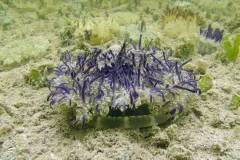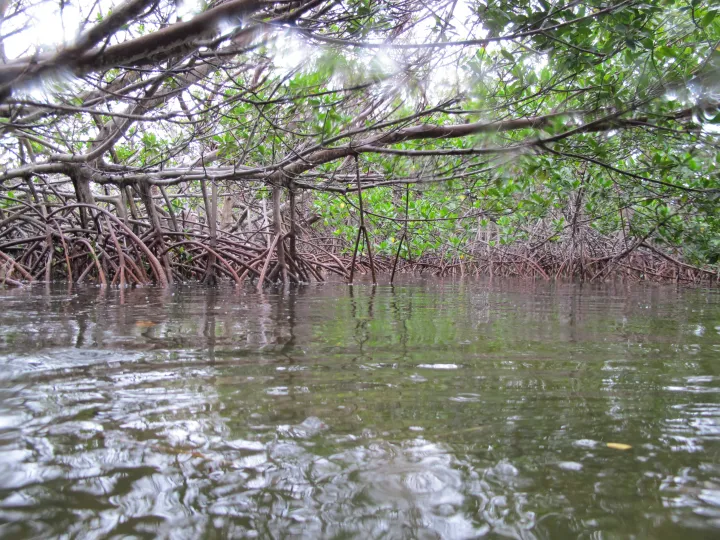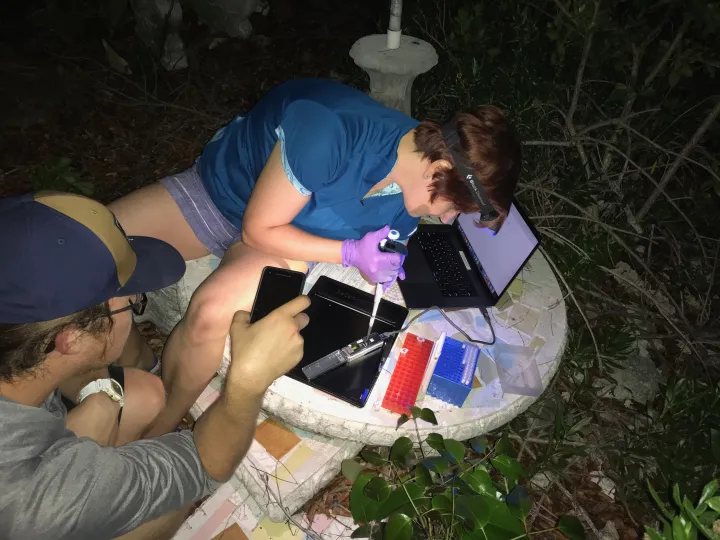Tracking Down Ocean Species On the Go Using eDNA

On a balmy Florida Keys day in May 2018, Cheryl Ames, a research collaborator at the Smithsonian’s National Museum of Natural History, trekked to the southern tip of the island chain in search of a particularly mucous-y jellyfish. Cassiopea xamachana, or the upside-down jellyfish, is known to eject prolific snot bombs containing stinging cells as a defense mechanism. She was there because, as spawning season began, a perfect concoction of eggs, sperm, and snot would disperse throughout the surrounding ocean. It was the perfect test location for a new portable technology that can identify the presence of a particular species with just a little sample of water.
Snot and feces are bodily fluids most would prefer to avoid. For marine ecologists like Ames, they have become a magical key to seeing the unseen. Any animal living in the ocean will inevitably leave behind traces of themselves, whether from a bowel movement or sloughed off skin. Luckily all these contain the creature’s DNA. Now, a single water sample collected from the ocean can be run through DNA sequencing technology to reveal the species living in an area. While environmental DNA (shortened to eDNA) research has been around for roughly the past 15 years in freshwater ecology and a decade in marine science, only recently has the technology become advanced enough to complete the entire sequencing process right at the time and place of collection. Ames’ goal is to use this technology to identify key species that would otherwise go unnoticed. Starting in an area with known species, like Cassiopea off the Keys, is the first step in showing the technology works.
“I had my doubts on whether it was even going to work, but to my surprise we got great results,” said Allen Collins, NOAA Fisheries affiliate invertebrate zoologist at the Smithsonian’s National Museum of Natural History and coauthor of a new paper outlining the portable eDNA process. “It is a great illustration of how creativity and gumption make for great science”
Using DNA for identification is a multistep process and one that has proven tricky to take to the field by making all the tools portable. First, the water must be filtered—that requires several sieves, a vacuum pump, and a small electronic blender to remove large particles. The eDNA is then isolated from the fine filter paper using more portable gadgets and chemicals, and then dressed up with DNA tags– something like molecular Velcro – to allow the sequencing machine to recognize the genes targeted in the experiments. Determining the identity of a species from small bits of DNA requires the use of a sequencer, a machine that traditionally takes up the whole desktop counter in a laboratory and requires an electrical outlet. A novelty of the portable technology used in this study – Nanopore technology— is that as the snippets of DNA feed through a microscopic pore, electrical pulses determine the unique code of that DNA strand. Instead of the traditional large and heavy setup used to complete such a task, Ames and her team were testing an upgraded system the size of a cellphone that can be powered by a computer. It has been a transition many have been wary of due to the high potential for failure.
“The first time we hooked up the Nanopore MinION sequencer to the external battery pack for the laptop computer that was running it, sparks literally began flying from the dongle connecting the two,” said Ames. “Promptly that sequencer stopped running, and we were like ‘Oh no! The data!’ Luckily, when we reinitiated the sequencing run, the data were all still there. Phew.”
A drop of the prepared eDNA molecular concoction added to the portable sequencer reveals on the screen the genetic code of all the DNA passing through it in real-time. Then, comes the job of comparing the codes to a huge database of sequences tied to specific species to identify which species are represented by the eDNA collected in the Florida Keys. This step proved to be another obstacle for remote use for two reasons. First, software for reading sequences on the Nanopore device was previously run via the internet. Likewise, the internet was commonly used by most researchers to access the humongous public sequence libraries (databases) and correspond software to comb through the library until it found a match. But since many remote locations are beyond the reach for even a hot spot, the need for internet was a major hindrance for bringing DNA identification beyond the walls of a laboratory. Luckily, this was an easy fix. A timely update by the sequencer manufacturer, changed the process to allow for the use of an offline version of the sequence reading software, and the team used a downloaded version of the pubic database and the software to search the sequences.
When Ames and team successfully connected the sequencer to the computer, row upon row of sequences began to emerge. And when they searched against the large database, low and behold, the majority of the matches were listed as Cassiopea, the upside-down jellyfish. The results brought a sigh of relief, said Ames, but it was even more exciting as other jellyfish species also began popping up. Over the course of the experiment, the moon jellyfish (Aurelia), and two venomous species of box jellyfish (Tamoya sp., and Alatina alata) known to cause severe stings in humans also appeared on the screen. None of these other species were actually observed during water sample collection, indicating that the process really could reveal species that would otherwise go unnoticed.
“My hope is that one day this is used for sting mitigation, almost like a weather forecast app that might report the daily ‘hurricane risk’, but instead that it would report ‘jellyfish stings risk’ at certain beaches,” said Ames. Ames has spent much of her time conducting research in areas where jelly stings are common, and warnings about whether venomous jellies are in the area could prevent countless injuries to swimmers.
Currently, portable sequencers are helping identify potential cases of Ebola during recent outbreaks and East African farmers in several countries are using the sequencers to identify plant pathogens in their crops. Additionally, the technology has been crucial to the rapid sequencing of the various Covid-19 virus variants, which has allowed for the efficient monitoring of outbreaks and disease spread. These examples indicate that more and more industries are seeing the potential of this type of technology. In the ecological field, the technology could also be used in fisheries and conservation, and indeed a great deal of testing of eDNA data is underway. Fisheries scientists could have the portable kit right on a boat where they could then test to see if populations of certain economically important fish were in the area. For conservation work, it could reveal the comeback or decline of a species of concern. Collins can imagine even bigger ambitions—a future where this type of technology is embedded in freely swimming rovers (Autonomous Underwater Vehicles) and as the rover surveys the area it is able to identify which species are there simply by sampling the water.
“We can’t do it yet, but I have no doubt this will become a reality,” said Collins.
Besides practical reasons, a future in which a sample of ocean water reveals the organisms in the vicinity would truly be a marvel. If the very first use of this portable lab kit is able to reveal jellyfish species previously unknown to exist in the area, we can only imagine at what other wonders it will reveal.
__________________________________
Ames, C.L., Ohdera, A.H., Colston, S.M., Collins, A.G., Fitt, W.K., Morandini, A.C., Erickson, J.S. and Vora, G.J., 2021. Fieldable Environmental DNA Sequencing to Assess Jellyfish Biodiversity in Nearshore Waters of the Florida Keys, United States. Frontiers in Marine Science.
https://www.frontiersin.org/articles/10.3389/fmars.2021.640527/full



